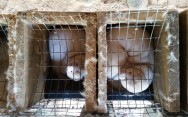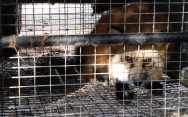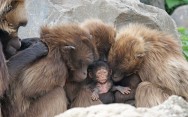Blog Archives
Home -
Posts tagged "primates"
Elon Musk is not exactly the world’s most liked figure. One more reason for negative publicity is the revelation that Neuralink, a startup Musk founded in 2016, has killed 1,500 animals since 2018. Allegedly many of the animals suffered horribly from botched experiments.
The animals in question are rhesus macaques who were undergoing experiments by the company to develop a brain chip implant that Neuralink claims could one day help paralyzed people to walk and blind people to see. Beyond the dazzling scientific pitch for this device, there are horrific reports of animals who had their skulls breached to implant the experimental device, and in one case (according to public records) gaps in an animal’s skull were filled with an unapproved adhesive which caused the animal to hemorrhage. In another case a monkey had nausea so severe she had open sores on her esophagus before she was killed. Animals suffered from chronic staph and other infections after having the brain chip implanted.
Other evidence for this horrific treatment is an impassioned internal letter written by an employee concerned about the need to slow down the pace to avoid “hack jobs” on the animals during the experimental surgery. The “break things and move fast” speed has been blamed for the company’s cruel and cavalier treatment of animals. Elon Musk apparently told employees at Neuralink to work “as if they had a bomb strapped to their head.”
The USDA Inspector General has opened a probe into potential Animal Welfare Act violations at Neuralink. This is not a common occurrence, as research standards are often left to institutional Animal Care and Research bodies at universities. The Animal Welfare Act doesn’t adequately protect many animals in the first place. Companion animals and other animals held in captivity have more protection than animals used in agriculture, mice and rats. Overall protections for animals used in research are inadequate.
The USDA probe suggests something has gone horribly wrong with the treatment of animals at Neuralink. Animals have become a casualty not only of a culture that disregards animals, but also of a capitalist, disposable culture of speed and greed.
Animal rights will never be a concern so long as we live in a culture where meeting production schedules are more valuable than life. In this culture, everyone is the product – whether it’s humans or defenseless research animals. Because animals can’t speak for themselves, we allow the abuse of research animals to continue. Paying attention to stories like this can help us stay alert to the violent realities of animal research and hold everyone involved accountable.
Just as the world’s most recent ape species was discovered, their habitat is about to be decimated. The Northern Sumatran Tanpanuli Orangutan was only discovered last year, and the population is already known to be the most endangered ape species in the world. The orangutans are threatened by Chinese diggers constructing a hydroelectric dam that will divide their habitat in two.
The dam has been opposed by leading environmentalists. Research in top scientific journals has shown that its impact will be disastrous. Yet it still goes ahead because of an injection of funding from the Chinese State Bank. Other major funders have pulled money based on the impacts on the orangutans, amongst other things. The reason why this disastrous project is being protected is that it is part of a huge Chinese plan for infrastructure to facilitate trade. Projects like this will spring up elsewhere, harming other wildlife.
Videos show orangutans clawing at diggers who are moving into their habitat. Orangutan literally means “man of the forest.” We must stop the advance of human works of such magnitude and harm. The vulnerable are counting on us. Please sign and share.
See Also:
https://news.mongabay.com/2018/07/scientists-urge-indonesian-president-to-nix-dam-in-orangutan-habitat/
https://www.theguardian.com/environment/radical-conservation/2018/apr/23/worlds-newest-great-ape-threatened-by-chinese-dam
This last week, the world has been in mourning for Koko the beloved mountain gorilla who learned to speak in American sign language. Koko was born on the 4th of July 1971, hence her name “Fireworks-child” (in Japanese), shortened to “Koko.” This fireworks child was a prodigy – she learned to play the recorder, and to sign over 1,000 signs and understand 2,000 words of spoken English. Koko was sad when she lost a pet, spoke about her longing for a child (the pet kitten was a close substitute) and talked about death and her own death. She also played with words and mixed them up in new combinations. She once described herself as a “fine-gorilla-person.”
Did humans teach Koko about language, or did Koko teach humans? Koko could speak in sign language,
but also more importantly, she could listen. When she listened, she interpreted things in her own way.
Despite criticism of the Koko project (which stated that Koko was mimicking her trainers), Koko
responded in unexpected ways. When she was asked where gorillas go to when they die, she said
“comfortable-hole-bye.” There were a few occasions when she expressed deep sadness and grief, like
when her pet kitten was hit by a car and killed.
Language is often used as an excuse to elevate humans above other animals. There were scientists who
felt Koko’s use of language was meaningless, as she didn’t learn grammar and syntax. But throughout
her life, Koko used sign language not as a lifeless toy or tool to get food and water, but a way to
communicate and describe her world. Communication –- rather than language –- was the key. Koko
and her researchers built a rapport together, where words could mean more than the dictionary
definition, they could mean complex emotional states and refer to shared understanding between
Koko and the researchers. Above all, what Koko taught us is that language is a human invention, but
communication is common to all animals. For that, we owe a debt to Koko, our Gorilla teacher.
that peacefully resolve conflicts between humans and non-human animals.









Social Media